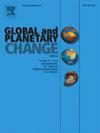Spatio-temporal changes in interannual sea level along the world coastlines
IF 4
1区 地球科学
Q1 GEOGRAPHY, PHYSICAL
引用次数: 0
Abstract
To investigate how coastal sea level evolves at interannual time scales from one region to another, we perform an Empirical Orthogonal Function (EOF) decomposition of coastal sea level time series derived from reprocessed coastalaltimetry data over a 20-year long time span (2002−2021), at 1132 virtual coastal stations homogeneously distributed along the world coastlines. This analysis is first performed globally and then over selected coastal regions. Consistent with previous studies, the results show the dominant influence of internal climate modes, in particular ENSO (El Niño Southern Oscillation), on the interannual coastal sea level variability. But our study also reports novel findings in coastal sea level: (1) a regime shift between 2008 and 2012, with increased sea level rate after that date in many coastal regions, and (2) a 6-year cycle, notably along the northeast and northwest coasts of America (north of 40°) and along the Indian coast of Indonesia. Additional EOF analyses are done using both gridded altimetry sea level data from the Copernicus Climate Change Service and an ensemble mean of four ocean reanalyses, in three successive coastal bands: 0-50 km, 50-100 km and 100-500 km from land. They confirm the strong influence of internal climate modes at the coast but also show that results in the cross-shore direction towards the open ocean are similar to those at the coast. This study based on three different datasets shows that the strong influence of internal climate modes on sea level interannual variability in the world coastal zones is not limited to the open ocean but also dominates sea level changes very close to the coast It also shows evidence of a regime shift in the rate of change of coastal sea level between 2008 and 2012 and the presence of a 6-year oscillation in coastal sea level, possibly linked to the recent discovery of a 6-year cycle in the whole climate system.世界海岸线海平面年际时空变化
为了研究沿海海平面在年际时间尺度上从一个地区到另一个地区的演变,我们对分布在世界海岸线均匀分布的1132个虚拟海岸站的沿海海平面时间序列进行了经验正交函数(EOF)分解,这些时间序列来自20年长时间跨度(2002 - 2021)的再处理沿海高度数据。该分析首先在全球范围内进行,然后在选定的沿海地区进行。与以往的研究结果一致,结果表明内部气候模态,特别是ENSO (El Niño南方涛动)对沿海海平面年际变化的影响占主导地位。但我们的研究也报告了沿海海平面的新发现:(1)2008年至2012年之间的政权转变,在此之后许多沿海地区的海平面上升速度增加;(2)6年 周期,特别是在美国东北和西北海岸(40°以北)和印度尼西亚的印度海岸。额外的EOF分析使用哥白尼气候变化服务的网格化高程海平面数据和四次海洋再分析的总体平均值,在三个连续的沿海带:距离陆地0-50 公里、50-100 公里和100-500 公里。他们证实了海岸内部气候模式的强烈影响,但也表明,朝开放海洋的跨海岸方向的结果与海岸的结果相似。这项基于三个不同数据集的研究表明,内部气候模态对世界沿海地区海平面年际变化的强烈影响不仅限于公海,而且还主导着非常靠近海岸的海平面变化。它还显示了2008年至2012年期间沿海海平面变化率的制度转变和沿海海平面存在6年振荡的证据。可能与最近在整个气候系统中发现的六年 周期有关。
本文章由计算机程序翻译,如有差异,请以英文原文为准。
求助全文
约1分钟内获得全文
求助全文
来源期刊

Global and Planetary Change
地学天文-地球科学综合
CiteScore
7.40
自引率
10.30%
发文量
226
审稿时长
63 days
期刊介绍:
The objective of the journal Global and Planetary Change is to provide a multi-disciplinary overview of the processes taking place in the Earth System and involved in planetary change over time. The journal focuses on records of the past and current state of the earth system, and future scenarios , and their link to global environmental change. Regional or process-oriented studies are welcome if they discuss global implications. Topics include, but are not limited to, changes in the dynamics and composition of the atmosphere, oceans and cryosphere, as well as climate change, sea level variation, observations/modelling of Earth processes from deep to (near-)surface and their coupling, global ecology, biogeography and the resilience/thresholds in ecosystems.
Key criteria for the consideration of manuscripts are (a) the relevance for the global scientific community and/or (b) the wider implications for global scale problems, preferably combined with (c) having a significance beyond a single discipline. A clear focus on key processes associated with planetary scale change is strongly encouraged.
Manuscripts can be submitted as either research contributions or as a review article. Every effort should be made towards the presentation of research outcomes in an understandable way for a broad readership.
 求助内容:
求助内容: 应助结果提醒方式:
应助结果提醒方式:


